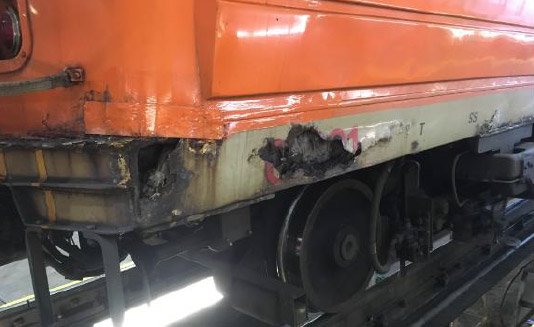
More Bondo, stat! From the report.
The MBTA last year quietly increased the spacing between trains during rush hour, decreasing the line's peak-time capacity by 25% and increasing the odds that frustrated passengers at certain stops won't even be able to get on a train at all because they're already full to bursting.
The T is now trying to speed up the Orange Line by putting down lines at key stations showing passengers where to stand for faster boarding and by having a sort of relay race at Forest Hills and Oak Grove, where fresh drivers now hop into the cab of an incoming train, rather than waiting for the incoming driver to walk the 382 feet down the platform from one end of the train to the other.
But new lines on platforms do little if the train is already in full sardine mode. Full relief may not come until 2022, when the T expects to roll out the last of the new Orange Line trains scheduled to be built in Springfield (delivery of a few cars could come in 2018, but those will be for testing). The T plans to buy 152 of the new cars to replace the current fleet of 120 cars, which reached their "end of design life" in the last century.
A report issued by the T earlier this week (2.4M PDF) shows that the "headway" between Orange Line trains has increased from 4 to 5 minutes in 2010 to 6 minutes today. In 2011, the T increased the headway to 5 to 6 minutes, "due to lack of vehicles" and then to a full 6 minutes last year, due to "growing ridership and lengthened scheduled travel times," the report states. The result:
Point checks at State Street in July 2015 showed heavy loads, 350 people passed by full trains in PM peak
The report does not specify the reason for the "lengthened scheduled travel times," but the change coincides with the opening of the new Assembly Square station.
The report also lists other key issues on the Orange Line, including the "obsolete" signaling system used on the tracks between Forest Hills and Back Bay, issues with the concrete used to support the tracks and the station power substations on that stretch and leaking tunnels at some stations.
Like the job UHub is doing? Consider a contribution. Thanks!
Ad:
Comments
Every picture tells a story.
By anon
Wed, 06/08/2016 - 2:28pm
Every picture tells a story. These decaying trains are absolutely a hazard to riders' lives. The MBTA is gambling with human lives every time they put a piece of duct tape and superglue on parts that are falling apart (or have already fell off!!) just to save a buck.
Six-minute peak headway is
By Rob
Wed, 06/08/2016 - 3:21pm
Six-minute peak headway is brutally high.
I did some temp work in NY/NJ area years ago, and sometimes worked with crews doing traffic counts.
I remember the project engineer explaining to me about headways. We were working at Atlantic Avenue in Brooklyn, near where the track for the inbound (Manhattan-bound) 2 & 3 trains and the track for the inbound 4 & 5 trains merge to a single track. Their theoretical best for that platform was about 90-95 seconds - physical limitations of speed, acceleration time, braking time, unloading time, loading time, how far out a departing train had to be to clear the block signal so the next train could enter, downstream congestion, etc... They did have a sufficiently large fleet to maintain that headway for some length of time.
If I recall correctly, they were pretty close to that 90-95 sec figure during the early part of rush hour. As crowds increased (both in the trains and on the platforms) during rush hour, however, loading and unloading took longer - pushed the headway to about 120 seconds.
Pages
Add comment